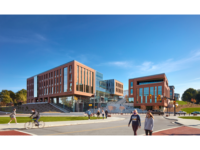Global architecture, design and branding firm Carrier Johnson + Culture, has announced the completion of a sustainability designed renovation and adaptation of a 1931 former infirmary building on the campus of Pitzer College in Claremont, California. At the same time, the firm is also announcing that the renovated building has received platinum level certification under the U.S. Green Building Council’s LEED standard.
A More Natural Setting
The Spanish revival style building, formerly the infirmary for Pitzer and several other Claremont Colleges, has re-opened as a home for the Robert Redford Conservancy for Southern California Sustainability, and for the Bernard Biological Field Station. The 10,500 square feet of the interiors include classrooms for science and the arts, conservancy offices, and an office and lab for the field station, as well as, exhibit space, informal study nooks, and two naturally ventilated sunrooms. The completed project, set within a 12-acre site north from the main campus, also takes full advantage of the pristine natural surroundings with the integration of 3,500 square feet of outdoor classrooms, plus lounge space and a “council ring” for face-to-face discussions in informal outdoor settings.
“Pitzer College has a longstanding tradition of sustainable practices and a number of award-winning, LEED certified buildings already on campus,” says Kevin Krumdieck, AIA, LEED AP BD+C, Principal with Carrier Johnson + CULTURE. “For these reasons, the home of the Robert Redford Conservancy, with its mission is to promote social and environmental awareness and wellbeing, had to exemplify best practices in green building.”
Sustainability in Design
The newly designed conservancy building has earned LEED Platinum, the highest level of certification awarded under the standard, says Krumdieck. On top of that, the academic building is also currently being monitored for a 12-month period in pursuit of another sustainability achievement, Net Zero Energy certification, indicating that the building produces at least as much energy as it consumes in operation. To help achieve this, news solar photovoltaic panels installed atop the roof structures of the two outdoor classrooms are planned to generate 88,000 kilowatt-hours annually.
Conserving Energy and History
Because the buildings’ redesign includes skylights and large-format glazing for maximizing penetration of natural daylight, plus passive strategies for thermal comfort, the solar energy generated from the panel arrays is expected to provide sufficient electricity for operation year round. According to Krumdieck, installing the solar panels on the outdoor classroom roofs, allowed the project to maintain the original historic character of the building. “Preserving the historic facades and form while adapting the interiors for sustainable educational uses created tremendous value for the college and the community. This approach is as green as it gets,” Krumdieck adds.
The director of the Redford Conservancy, Pitzer’s Associate Professor of environmental analysis, Brinda Sarathy, oversaw the planning for the new facility. The resulting Carrier Johnson + CULTURE led project, “embodies beauty, sustainability, and a spirit of true collaboration,” said Sarathy.
Natural and Low-impact Design
The sustainable design methods employed emphasize natural and low-impact design. Krumdieck points to the landscape design as an example, the project designers identified drought-tolerant, native plant species that enrich the site, and the local ecology. Paved areas are porous, and minimized to accommodate service and emergency access, increasing the natural sensibility of the Redford Conservancy’s site.
“The result is a demonstration of what truly sustainable design can achieve,” says Krumdieck. “We’re proud to have contributed to transforming a beautiful historic site into a dynamic new academic facility for Pitzer. This is a facility that unites the past and the future, while celebrating the Robert Redford Conservancy’s mission through its creation.







